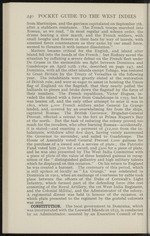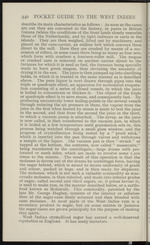| 1 |
 |
“...240 POCKET GUIDE TO THE WEST INDIES
from Martinique, and the garrison capitulated on September 7th,
after a stubborn resistance. The French troops marched into
Roseau, as we read, " in most regular and solemn order, the
drums beating a slow march, and the French soldiers, with
small boughs and flowers in their hats by way of laurels, with
assumed fierce countenances as they came by our small force,
seemed to threaten it with instant dissolution.”
Matters became critical for the English, and island after
island fell into the hands of the French ; but Rodney saved the
situation by inflicting a, severe defeat on the French fleet under
De Grasse in the memorable sea fight between Dominica and
Guadeloupe on April 12th 1782, described on page 247, and
Dominica, with all the other islands except Tobago, was restored
to Great Britain by the Treaty of Versailles in the following
year. The inhabitants were greatly elated at the. restoration
of British rule, and were so eager to assist in hoisting...”
|
|
| 2 |
 |
“...is boiled at a low temperature until granulation sets in, this
process being watched through a small glass window, and the
progress of crystallisation being tested by a " proof stick,”
which is inserted into the pan through valves and withdraws
a sample of the liquor. The vacuum pan is then " struck ” or
tapped at the bottom, the contents, now called " massecuite,”
being transferred to the centrifugals,—large drums with per-
forated or mésh sides, which axe made to revolve some 1,200
times to the minute. The result of this operation is that the
molasses is driven out of the drums by centrifugal force, leaving
the sugar behind, which is mixed to secure uniformity of grade
and colour, packed in bags, and is then ready for shipment.
The molasses, which is not such a valuable commodity as mus-
covado molasses, is then reboiled, and made into inferior grades
of sugar, called second and third sugars, or, if prices favour it,
is used to make rum, in the manner described below, or a cattle-
food...”
|
|
